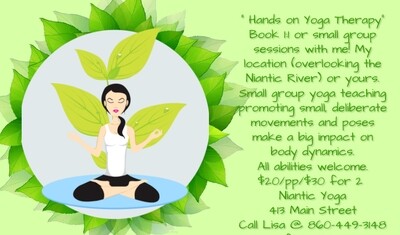

My Story & Approach
We are always where we need to be.
I am a trained yoga teacher and health coach and I am in advanced yoga therapy training, of which I have completed two years. I specialize in serving individuals with challenges of all kinds, be they physical or otherwise. I work with everyone but excel at helping those with pain, fatigue, chronic illness and disabilities. I make everything accessible to the student, and, therefore, prefer to work in small groups or 1:1. I also like to bring the "why" of what we do, providing background, stories, metaphors or yoga history as necessary. I am serious about what I do, but try to deliver it in a light, encouraging manner.
Click on the image of the class you'd like to register for:

Blog/Articles
SCROLL DOWN/ARTICLES ARE CHRONOLOGICAL
Don’t Be So “Sympathetic”!
by Lisa Terenzio, from the Lyme Times, April 2022
More than ever, we are searching for a way to mitigate the stress in our lives. Countless books are written and seminars are offered as folks search for a way to de-escalate stress and try to reverse the havoc it causes in our bodies and minds. But is the process really complex and elusive?
Our nervous system has two modes, sympathetic and parasympathetic. To simplify, the former features “fight or flight” impulses and the latter “rest and digest”. The sympathetic system becomes involved when we perceive a threat or stressful situation and signals our bodies to bring blood to our arms (to fight the threat) or legs (to run away). For our primitive ancestors, whose basic survival depended upon eternal vigilance, this feature worked well. In modern, civilized life, however, threats are generally more theoretical or at least indirect. The problem arises because the primitive portion of our brain cannot distinguish between the specter of a predator and a letter from the Internal Revenue Service. Feeling threatened by the letter and secreting all of those powerful sympathetic neurotransmitters is not useful in combating the perceived threat and might even be counterproductive. We carry these experiences, and the neurochemicals that we’ve produced while reacting, long after the “threat” is gone. We will even revive and ruminate on perceived injustices and injuries during what would otherwise be a subsequent peaceful moment. This is because the sympathetic response is largely maladaptive today. It simply is not necessary, or even advisable, to respond—even internally—to every stimulus that presents itself.
One excellent way to flex your parasympathetic power is through yoga and meditation. Not only will you have peace and quiet during your practice but you will also be developing equanimity to bring forward into the rest of your life. And that is stress reduction!
The Nourishing Twilight Sleep of Yoga Nidra by Lisa Terenzio, from The Lyme Times, May 2022
There are different types of brain waves that dominate in different states of human consciousness and they include beta (wakefulness/activity), alpha (calming down), theta (REM sleep) and delta (a blissful in-between state). Due to a myriad of factors, we don’t get enough delta-quality rest and our bodies, brains and vital organs do not regenerate as fully as they might. Without enough modulation of these brain waves, getting them to fluctuate and work together, we more easily experience fatigue, disease and mental or psychological stress.
There is a specialized yogic practice called Yoga Nidra that guides participants into a deep, facilitated rest. It starts with making a comfortable “bed” on the floor and assuming the corpse pose or “savasana”. As you are verbally cued by the instructor, your brain shifts from beta waves (state of awakening with lots of brain activity), to alpha waves, with your eyes closed where you can rest and digest. In this state, the mood-enhancing hormone serotonin is released, and you feel settled and well. Continuing this process, Yoga Nidra produces low beta, increases and balances alpha and theta, ultimately producing delta waves. Here, you are receptive to processing emotions and letting go of those bits that no longer serve you. Physically, you might process and eliminate stress hormones and nourish your organs. Your mind will continue to slow down and has no conscious agenda but your conscious and unconscious mind can communicate with each other.
While many people fall into traditional sleep during Yoga Nidra, it is most effective if participants remain in the “twilight” between waking and sleeping. It is very safe space and you are in control at all times. The session will come to an end where you may reconnect to an intention you set at the start of the class or with other methods of bringing you awake. Most people find that adding Yoga Nidra to their practice or self-care routine helps to improve all aspects of their wellbeing.
PTSD and Yoga: Releasing the Issues from our Tissues by Lisa Terenzio, from The Lyme Times, June 2022
Our body is a meticulous record keeper of everything that has happened to us and, naturally, the more profound the events, the more profound the effect. But the question becomes, where is this “stuff” being stored? It turns out that experience is not only stored in our brain as memory but also elsewhere in our bodies. As Dr. Bessel Van Der Kolk says in his bestselling book on trauma and healing “The Body Keeps the Score”, trauma is a fact of life. But some people’s trauma is sustained and repetitive so that the old is mixed with reinjury causing a debilitating cycle. In his book Dr. Kolk chronicles his own research studies with combat veterans and the success he has had reshaping participants’ use of their bodies and brains through meditation, yoga and neurofeedback. The thesis is that we store experiences, including trauma, not only in our brain as memory but also literally in our tissues. Sometimes referred to as “pain memory”, it is what can get us into trouble when we “stuff away” experiences that are too painful to address every day. If they are never addressed and are not released from our system, they then continue to produce other, often unexpected negative effects on our health. Such is the case with a group of experiences that result in a condition referred to PTSD or post-traumatic stress disorder, a common condition among combat veterans. Working through somatic or cellular practices, instead of, or in addition to “talk therapy”, we can circumvent the brain, with its powerful defensive mechanisms and get right to our body directly. Modalities to help release trauma are delivered by teachers or coaches that are specially trained so that participants feel safe at all times. The practitioner, with client feedback, identifies the location and character of what is being stored (for example, lower back pain which can be both physical and psychological) and then a protocol is developed to slowly and safely release it.
Energy, Wellbeing and the Concept of Vibration, by Lisa Terenzio, from The Lyme Times, July 2022
A cursory study of physics reveals that pretty much everything, everywhere is vibrating. The world is made up of vibrational energy masquerading as static objects and substances. The same is true of human bodies. We all vibrate energetically at a particular frequency. The lower the frequency, the denser your energy, and the heavier your problems seem. Here you may experience pain and discomfort in your physical body and feel heavy emotions and mental confusion. Everything seems like a big deal and all tasks are difficult. Finally, we turn it upon ourselves, feeling shame and inadequacy or throwing blame at others.
Conversely, the higher the frequency of your energy or vibration, the more connected and buoyant you feel in your physical, emotional, and mental bodies. You experience greater competence, clarity, peace, love, and happiness. Any pain you have is manageable or lessened, your emotions are better modulated and you feel light, energetic and hopeful --literally full of light! Your life flows with synchronicity, and the things you want for your life take shape. There is a sense of flow and we connect better with other people.
Wonderful news! It is possible to raise the vibration of your being and you already possess all that is needed to do so. It requires only your attentiveness to your habits, observing them in a neutral manner, without judgment. It does not all happen overnight, but as you progress up the vibrational continuum, you will feel lighter, more engaged and restored.
First: Practicing meditation, yoga, tai chi or a meditative walk in nature 2-3 times per week are all ways to kick start the awareness portion of the program.
Second: practicing appreciation of yourself and others and bringing gratitude into your consciousness as much as possible. These states of being are like muscles, the more you use them, the more robust they will become. Soon you will look back and wonder where all the grey clouds of your lower vibration self have gone!
Third: Observe who is in your life. Higher vibration individuals attract like individuals. Pay careful attention to the “vibe” of your relationships. Move away from draining, blaming, gossipy and judgmental folks. You don’t necessarily have to cut them off, just direct less energy there. Meanwhile, seek out, work and play with the people who bring joy, whose presence you welcome and embrace their friendship.
If you do these things gradually and with purpose, the process will take on a life of its own and you can only keep progressing!
Yoga Trends 2022-23: You Don’t Have to Go Far to Get Away!
By Lisa Terenzio, to be published in The Lyme Times, August 2022
While many people wish they could go on a week or two-long yoga retreat to Costa Rica, Mexico or Thailand, it isn’t always in the budget, financially or timewise. Enter single-day yoga retreats! One day retreats offer the benefit of real rest and relaxation—maximum benefit for minimum investment. Of course, participants will have to be ready to lean in and tune out to get into the flow of the day. These retreats include offerings such as in person yoga classes, meditation sessions, pose workshops, and lots of sharing and fellowship. Single-day yoga retreats also sometimes include cacao ceremonies, music/kirtan and sound bath sessions which help participants to fully immerse in the experience. Such retreats may be run by yoga studios or popular teachers who collaborate to make the activities varied and all lend their expertise.
I’ll elaborate on some of the concepts above for those who are not familiar. Think of cacao as an enhanced cocoa. Unlike coffee, which contains a high-concentration of caffeine that stimulates the nervous system and can make you jittery, ceremonial cacao contains theobromine and can give you the feeling of a warm and uplifting “hum”. Theobromine, which translates to "food of the gods". Cacao also contains tryptophan, which makes people feel calm and relaxed. It is no more of a “drug” than coffee and is much gentler on the system.
Kirtan is derived from the Sanskrit root meaning to call, recite, praise, or glorify. Modern kirtan often does not include a specific denominational praise, but is a general call to higher power and rejoicing. Modes of expression may include poetry, dance, call and response singing with or without instruments such as a harmonium or guitar.
In a sound bath, participants passively “soak in” the benefits of sound. Participants are immersed in the vibrations of, for example, gongs, rain sticks, crystal bowls and bells while lying comfortably on mats and blankets.
All in all, one day retreats are the ultimate getaway right in your own neighborhood or town and you will feel rested and rejuvenated as if you had travelled the distance to a remote location.
Lisa Terenzio is a Health Coach and Yoga Therapist teaching at Niantic Yoga Studio and by appointment. One-day retreats will be announced on https://lisaterenzioyoga.company.site/ and https://nianticyoga.com/
What is Yoga Therapy?
How is it different from yoga or physical therapy?
Physical Therapists are body only therapists. They go through extensive schooling to learn protocols to help with all areas of human muscular/structural dysfunction. Every day, physical therapists treat patient’s painful hips, dysfunctional shoulders, back pain etc. They also often have physical manipulation skills. They can perform passive techniques to help muscles relax. Although they are not Medical Doctors, they are trained in diagnostic tests to figure out the root of physical problems. PT’s are very useful in helping with injuries and rehabbing from surgeries. PT’s are often limited by insurance considerations in terms of how they work and the time they can spend with patients.
Yoga Therapists complete a series of yoga therapy courses and work on a whole person model. When working with physical issues, a Yoga Therapist is trained to work with muscular imbalances. They are trained in anatomy and how different movement patterns can help heal specific conditions. Yoga Therapists are also taught how to assess breathing patterns and how they might affect pain and healing outcomes. In addition, a Yoga Therapist is trained in how to work with someone to optimize their healing potential. So not only do we work with movement and breath patterns, yoga therapy often includes working with different mental states, specific breathing techniques, and meditation.
Under Construction
Reviews: Under Construction

Explore Our Catalog of Products
Fun, whimsical items, some yoga related, some inspirational!
Contact Us
Our Address
413 Main Street, Niantic, CT 06357
Open hours
By appointment or booking a class/session


